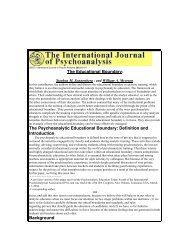Coagulation Factors in Controlling Traumatic Bleeds: FFP, PCC, or ...
Coagulation Factors in Controlling Traumatic Bleeds: FFP, PCC, or ...
Coagulation Factors in Controlling Traumatic Bleeds: FFP, PCC, or ...
Create successful ePaper yourself
Turn your PDF publications into a flip-book with our unique Google optimized e-Paper software.
f. The<strong>or</strong>ies beh<strong>in</strong>d mechanism 37<br />
i. Orig<strong>in</strong>al thought: supra-physiological concentrations speed up tissue FVIIa-mediated reaction,<br />
result<strong>in</strong>g <strong>in</strong> m<strong>or</strong>e thromb<strong>in</strong> generation<br />
1. Problem: concentrations of rFVIIa required f<strong>or</strong> hemostatic efficacy were far greater than what<br />
would be required to saturate TF<br />
ii. Cell-based system: rFVIIa can b<strong>in</strong>d to platelets and directly activate FX and FIX without TF<br />
iii. Recent data: when adm<strong>in</strong>istered <strong>in</strong> doses sufficient to bypass need f<strong>or</strong> FVIII <strong>or</strong> FIX, rFVIIa b<strong>in</strong>ds to<br />
surface of activated platelets <strong>in</strong> TF-<strong>in</strong>dependent manner and promotes FX activation and<br />
thromb<strong>in</strong> generation<br />
XV. Summary of available options 21<br />
Characteristic <strong>FFP</strong> <strong>PCC</strong> rFVIIa<br />
FII<br />
FVII<br />
FIX<br />
FX<br />
✓<br />
✓<br />
✓<br />
✓<br />
✓<br />
+/-<br />
✓<br />
✓<br />
✓<br />
Other<br />
Fibr<strong>in</strong>ogen<br />
vWF<br />
Antithromb<strong>in</strong><br />
+/- Prote<strong>in</strong>s C and S<br />
+/- Hepar<strong>in</strong><br />
Time to effect 10 m<strong>in</strong> 10 m<strong>in</strong> 10 m<strong>in</strong><br />
t1/2 1.5-2 days 6-8 hrs < 60 m<strong>in</strong><br />
CLINICAL EVIDENCE : WIT H PR E -INJUR Y WAR F AR IN<br />
Nishijima DK, et al. The efficacy of fact<strong>or</strong> VIIa <strong>in</strong> emergency department patients with warfar<strong>in</strong> use and traumatic<br />
<strong>in</strong>tracranial hem<strong>or</strong>rhage. 2010. 39<br />
Design<br />
Retrospective bef<strong>or</strong>e-and-after study<br />
Population 40 patients with pre-<strong>in</strong>jury warfar<strong>in</strong> use, traumatic <strong>in</strong>tracranial hem<strong>or</strong>rhage, and INR ≥ 1.3<br />
Protocol: adm<strong>in</strong>istration of 1.2 mg rFVIIa <strong>in</strong> the ED and standard treatment (<strong>FFP</strong> + vitam<strong>in</strong> K)<br />
Endpo<strong>in</strong>ts Primary: <strong>in</strong>-hospital m<strong>or</strong>tality<br />
Secondary: m<strong>or</strong>tality at 48 hrs and 30 days; successful reversal of anticoagulation (INR

















